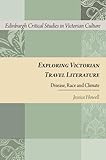Exploring Victorian Travel Literature : Disease, Race and Climate / Jessica Howell.
Material type: TextSeries: Edinburgh Critical Studies in Victorian Culture : ECSVCPublisher: Edinburgh : Edinburgh University Press, [2022]Copyright date: ©2014Description: 1 online resource (208 p.)Content type:
TextSeries: Edinburgh Critical Studies in Victorian Culture : ECSVCPublisher: Edinburgh : Edinburgh University Press, [2022]Copyright date: ©2014Description: 1 online resource (208 p.)Content type: - 9780748692958
- 9780748692965
- 828.8/00932 23
- PR756.T72 H69 2014
- PR756.T72 H69 2014
- online - DeGruyter
- Issued also in print.
| Item type | Current library | Call number | URL | Status | Notes | Barcode | |
|---|---|---|---|---|---|---|---|
 eBook
eBook
|
Biblioteca "Angelicum" Pont. Univ. S.Tommaso d'Aquino Nuvola online | online - DeGruyter (Browse shelf(Opens below)) | Online access | Not for loan (Accesso limitato) | Accesso per gli utenti autorizzati / Access for authorized users | (dgr)9780748692965 |
Frontmatter -- Contents -- Series Editor's Preface -- Acknowledgements -- Introduction -- Chapter 1 Mrs Seacole Prescribes Hybridity: Climate and the Victorian Mixedrace Subject -- Chapter 2 Mapping Miasma, Containing Fear: Richard Burton in West Africa -- Chapter 3 Africanus Horton and the Climate of African Nationalism -- Chapter 4 'Climate proof': Mary Kingsley and the Health of Women Travellers -- Chapter 5 'Self rather seedy': Conrad's Colonial Pathographies -- Conclusion: The Afterlife of Climate -- Bibliography -- Index
restricted access online access with authorization star
http://purl.org/coar/access_right/c_16ec
Studies representations of white illness in Victorian travel narratives about Africa and the CaribbeanGBS_insertPreviewButtonPopup(['ISBN: 9780748692958','ISBN: 9780748692965']);This interdisciplinary study explores both the personal and political significance of climate in the Victorian imagination. It analyses foreboding imagery of miasma, sludge and rot across non-fictional and fictional travel narratives, speeches, private journals and medical advice tracts. Well-known authors such as Joseph Conrad are placed in dialogue with minority writers such as Mary Seacole and Africanus Horton in order to understand their different approaches to representing white illness abroad. The project also considers postcolonial texts such as Wilson Harris's Palace of the Peacock to demonstrate that authors continue to 'write back' to the legacies of colonialism by using images of climate induced illness. Key FeaturesOffers a new perspective on the study of Victorian literature and imperialism by studying depictions of white bodies made ill by the tropical environmentBridges the critical approaches of illness narrative analysis, race and travel studiesAnalyses canonical travel literature alongside works by lesser known and minority authorsShows the pervasive afterlife of climate in the cultural imagination, even after the discoveries of germ theory and contagionism"
Issued also in print.
Mode of access: Internet via World Wide Web.
In English.
Description based on online resource; title from PDF title page (publisher's Web site, viewed 02. Mrz 2022)


